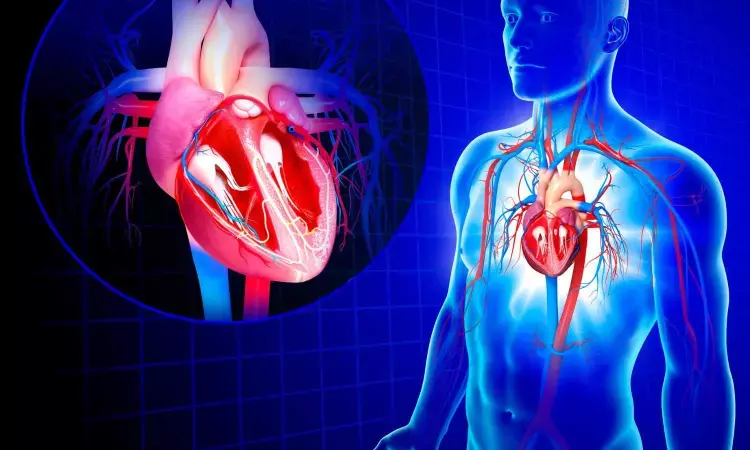- Home
- Medical news & Guidelines
- Anesthesiology
- Cardiology and CTVS
- Critical Care
- Dentistry
- Dermatology
- Diabetes and Endocrinology
- ENT
- Gastroenterology
- Medicine
- Nephrology
- Neurology
- Obstretics-Gynaecology
- Oncology
- Ophthalmology
- Orthopaedics
- Pediatrics-Neonatology
- Psychiatry
- Pulmonology
- Radiology
- Surgery
- Urology
- Laboratory Medicine
- Diet
- Nursing
- Paramedical
- Physiotherapy
- Health news
- Fact Check
- Bone Health Fact Check
- Brain Health Fact Check
- Cancer Related Fact Check
- Child Care Fact Check
- Dental and oral health fact check
- Diabetes and metabolic health fact check
- Diet and Nutrition Fact Check
- Eye and ENT Care Fact Check
- Fitness fact check
- Gut health fact check
- Heart health fact check
- Kidney health fact check
- Medical education fact check
- Men's health fact check
- Respiratory fact check
- Skin and hair care fact check
- Vaccine and Immunization fact check
- Women's health fact check
- AYUSH
- State News
- Andaman and Nicobar Islands
- Andhra Pradesh
- Arunachal Pradesh
- Assam
- Bihar
- Chandigarh
- Chattisgarh
- Dadra and Nagar Haveli
- Daman and Diu
- Delhi
- Goa
- Gujarat
- Haryana
- Himachal Pradesh
- Jammu & Kashmir
- Jharkhand
- Karnataka
- Kerala
- Ladakh
- Lakshadweep
- Madhya Pradesh
- Maharashtra
- Manipur
- Meghalaya
- Mizoram
- Nagaland
- Odisha
- Puducherry
- Punjab
- Rajasthan
- Sikkim
- Tamil Nadu
- Telangana
- Tripura
- Uttar Pradesh
- Uttrakhand
- West Bengal
- Medical Education
- Industry
Study finds elevated LVFP in 11 percent of patients with CTEPH at the time of diagnosis

Austria: A recent study published in the Journal of the American College of Cardiology has found that one-third of patients with chronic thromboembolic pulmonary hypertension (CTEPH) also have left heart disease.
In the past, the possibility of overlap between these two conditions had not been considered in diagnosing and treating CTEPH patients.
The long-term analysis designed by Christian Gerges and Irene Lang at the Department of Medicine II of the University Hospital Vienna and MedUni Vienna is based on the systematic examination of 611 patients diagnosed between 1993 and 2019 at the Division of Cardiology at the Department of Medicine II together with the Department of Thoracic Surgery of the University Hospital Vienna and MedUni Vienna. For this purpose, precise haemodynamic measurements by means of right and left heart catheters were evaluated and carried out at the Division of Cardiology in the cardiac catheterisation laboratory. The results show that left heart disease can occur simultaneously with chronic thromboembolic pulmonary hypertension. Previously, this overlap had not been considered in diagnosis and treatment. "Until now, guidelines for diagnosing chronic thromboembolic pulmonary hypertension have required only examination of the pulmonary circulation. The possibility that CTEPH patients are also affected by left heart disease were not considered in the diagnostic process.
The long-term study results now show that one-third of CTEPH patients also have left heart disease," says Irene Lang, head of the study and head of the outpatient ward for pulmonary vascular diseases, Division of Cardiology, of the MedUni Vienna and University Hospital Vienna.
As is the case with left heart disease, a filling disease of the left ventricle, the most important chamber of the heart from which blood is supplied to the organs, this specific form of pulmonary hypertension aggravates breathing. Clinically, the two diseases are difficult to distinguish from each other. Both conditions occur primarily during middle to older age. "The results of the analysis provide evidence that the guidelines for CTEPH diagnosis should be expanded to include left heart catheterisation, because CTEPH and left heart disease may coexist, which impacts prognosis", says Lang.
The result of the analysis also bears out on drug treatment. Lang sees new challenges here, as drugs approved for pulmonary hypertension and CTEPH may be harmful in left heart disease. Building on the long-term study results, the task now is to work out the overlap between the two conditions in more detail and find drugs that can treat both diseases.
Chronic thromboembolic pulmonary hypertension (CTEPH): a rare disease
Chronic thromboembolic pulmonary hypertension (CTEPH) is a specific form of pulmonary hypertension and a severe complication of acute pulmonary embolism easily overlooked. With a prevalence of 50 per million, CTEPH is a rare disease. While the diagnosis was still associated with a poor prognosis in the 1980s, the prognosis for CTEPH patients has improved considerably during recent decades due to new treatment options. Today, in specialised pulmonary vascular disease centres such as the one at the University Hospital Vienna and MedUni Vienna, where multidisciplinary teams of cardiology, radiology, pulmonology and thoracic surgery work closely together and which is a member of the European Reference Network (ERN), patients have three independent treatment options at their disposal: targeted drug therapy, a surgical procedure and a percutaneous procedure.
Reference:
Christian Gerges, Anna-Maria Pistritto, Mario Gerges, Richard Friewald, Valerie Hartig, Thomas M. Hofbauer, Benedikt Reil, Leon Engel, Varius Dannenberg, Stefan P. Kastl, Nika Skoro-Sajer, Bernhard Moser, Shahrokh Taghavi, Walter Klepetko, Irene M. Lang, Left Ventricular Filling Pressure in Chronic Thromboembolic Pulmonary Hypertension, Journal of the American College of Cardiology, https://doi.org/10.1016/j.jacc.2022.11.049.
Dr Kamal Kant Kohli-MBBS, DTCD- a chest specialist with more than 30 years of practice and a flair for writing clinical articles, Dr Kamal Kant Kohli joined Medical Dialogues as a Chief Editor of Medical News. Besides writing articles, as an editor, he proofreads and verifies all the medical content published on Medical Dialogues including those coming from journals, studies,medical conferences,guidelines etc. Email: drkohli@medicaldialogues.in. Contact no. 011-43720751


